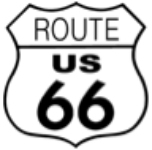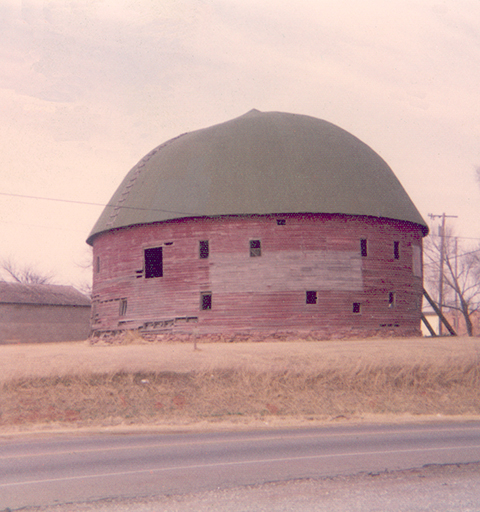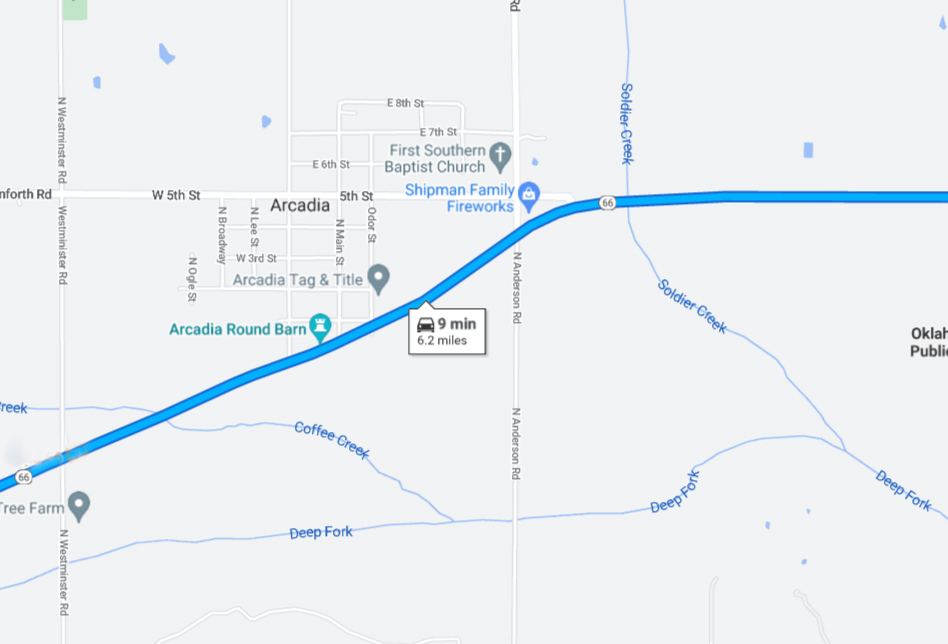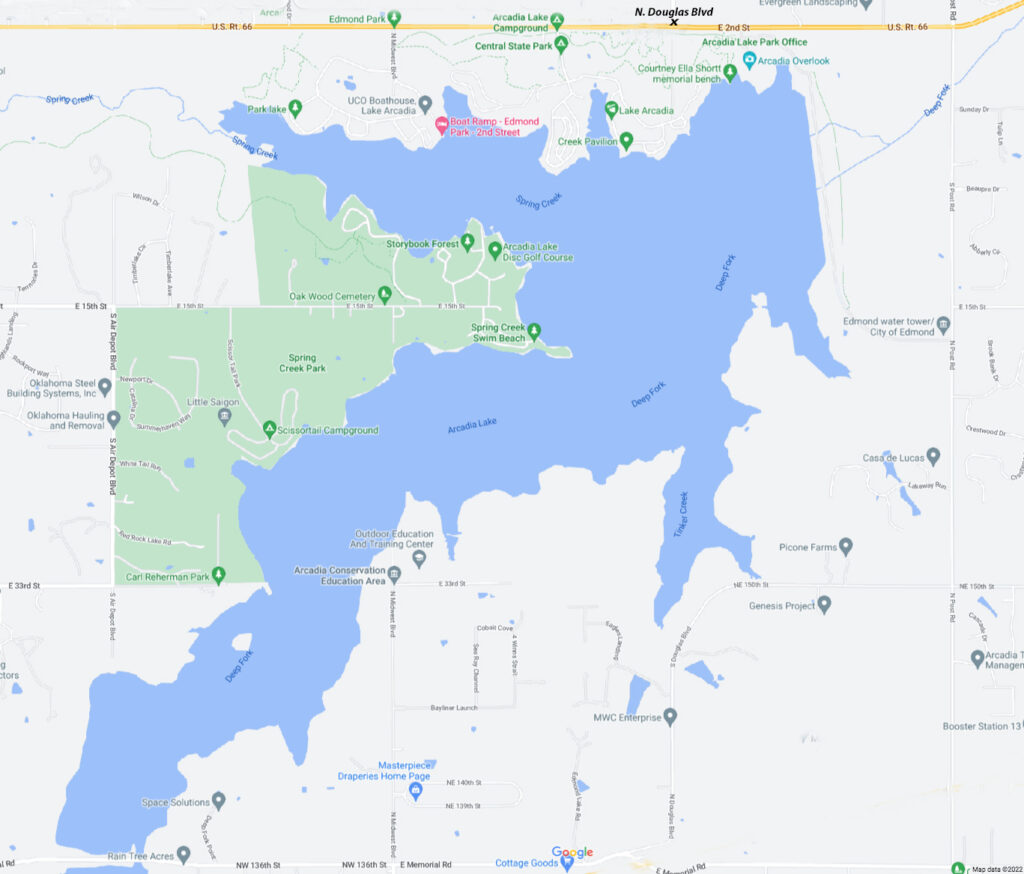
Luke points out the Round Barn, “They had dances on the second floor. My oh my, Sis and I had the moves; we loved to dance. At the Round Barn the music just took over, surrounded us, went right through us; it was great.”

In the last blog entry about the *Atkins Family’s 1948 U.S. Route 66 journey west, the family has just left the scenic spot where Washington Irving stopped in 1832 when he was exploring the Oklahoma Territory, as later reported in his book “Tour of the Prairies”.
At Arcadia, after crossing Soldier creek, Route 66 curves sharply downward and passes immediately south of the small town of Arcadia.
On Route 66, they approach the Round Barn on the right, the north side of the road.

The Round Barn was built by William Harrison Odor in 1898, and believed to be the only one in existence in the U.S. at the time. In 1892, Big Bill, as he was called, claimed land in Oklahoma County around the Deep Fork River and its tributaries and started to farm. In 1898 he designed and began to build a large round barn on a rise north of the Deep Fork River, using local red Permian rock for the foundation. For the walls and roof rafters, he used native bur oak wood, that was cut into boards, soaked in water while green and set in special molds to bend them into the curved shape needed. The finished barn was 60 feet in diameter and 43 feet high.
When the barn was nearly complete, three of his young workers, urged him to install hardwood flooring suitable for dancing on the upper level, and they agreed to pay he difference between normal barn flooring and the more expensive hardwood. Big Bill took them up on their offer. For years after that, he periodically held dances on the second level that drew musicians and crowds from a wide area. They raved about the barns’ great sound. Big Bill and others compared the acoustics to the Mormon Tabernacle in Salt Lake City.
Later, in 1914, Oklahoma County obtained a right-of-way through his property and built a crude dirt road that ran beside the barn. It was part of State Highway 7. When State Highway 7 was paved and designated as U.S. Route 66 through Arcadia in 1928, it put the Round Barn in a prominent spot.
Luke points it out, “See that round barn; it’s run down now, but when it was new, it was a pretty sight.”
“I wonder why they made it round,” Grace says.
“The owner designed it that way. There was a rumor that he made it round because of Tornadoes. He thought they would swirl around it instead of wiping it out, but I really don’t know.”
All three kids perk up and look at the barn.
“He used to have dances on the second floor,” Luke continues. “Me and my sister Betty went one time.”
“When was that?”
“I don’t remember exactly when, maybe 1925, when I was 15. This road was just dirt then, and still called highway 7, not 66.”
He shakes his head and laughs a little at the memory, “My oh my, Sis and I had the moves. We loved to dance. At the Round Barn the music just took over, surrounded us, went right through us; it was great. The band began playing this fast jumping tune, and we got out on the floor and started doing the jitterbug. I bounced her off one of my hips then the other, and a few couples just stopped to watch us, then I threw her between my legs, and a few more stopped to watch. Then I threw her over my shoulder, and all the other dancers stopped to watch. Before the song was half over, everyone in the whole place was standing around stomping their feet, clapping their hands, watching us, and egging us on. It was something; let me tell you. We never missed a beat. Everybody just cleared the floor and watched us. For the rest of the night, we were the entertainment.”
“Sounds fun,” Says Carl, Luke’s ten-year-old son.
“It was. We loved to dance.”
Six-year-old Darla says, “I’ve never seen you dance Daddy.”
“No, I don’t dance anymore. I gave that up when I became a Christian.”
“Why”
“It’s not Christian-like. I don’t believe in it anymore. Leads to bad things.”
“What bad things?”
“Never mind. Just don’t do it.”
All three kids noticed that Luke had a shiny excited look about him as he talked about dancing. They wonder what’s bad about it, but don’t ask any further. Still they want to see him dance.
Luke becomes quiet and continues driving through Arcadia, passing over the Coffee Creek Bridge.
Deep Fork River Branches
The Deep Fork River is still running to the south of Route 66. Both Soldier Creek and Coffee Creek branch off the Deep Fork River. Heading west, Soldier Creek crosses under Route 66 just before Arcadia, and Coffee Creek crosses under not long after passing the Round Barn, and shortly before N. Westminister Rd. The Deep Fork River continues to Arcadia Lake.


The Deep Fork River flows easterly, runs from its headwaters in Oklahoma City, enters Arcadia Lake from the southwest tip, is impounded for five miles, then flows out from the northeast side to continue its meandering journey to empty into the North Canadian River, and since 1956, into Lake Eufaula.
The Atkins family reaches Arcadia Lake 1.5 miles west of Arcadia, positioned on the south side of Route 66, which, by this time, is also E. 2nd Street and leading them directly into Edmond.
Coming Next: “1948 Oklahoma City Area, Edmond, OKC Route 66 Beltline.”
Notes:
*The Atkins Family: Luke (Father, 38), Grace (Mother, 29), Carl age 10,) Darla (age 6,) Nancy (age 4.)
Because of my need to slash the word count of my book from nearly 130,000 to fewer than 100,000, many cuts are those that added to historical value rather than story. It makes me sad because I like those historical references. I hope that by presenting some of those here, I can share an authentic 1948 trip down Route 66 and add a little extra as I go.
My parents made a real 1948 trip to California and my mother kept a diary, which I faithfully used in planning this fictional trip.
Cuts: They have been made to my book and it is now about 99,000 words. Yeah!
Credits:
Jack D. Rittenhouse, (1946). A Guide Book to Highway 66
okcrt66.pdf www.okhistory.org. “The Oklahoman” Robert E. Lee, Jan 2 1998.
Image Credits:
- 1937 Chevy 4-door Sedan: Photoshop on personal picture.
- R66 Shield pngegg.com
- Old Round Barn (image 1940) www.metrolibrary.org
- Deep Fork Branches Google Maps Screenshot crop
- Arcadia Lake Google Maps Screenshot crop
